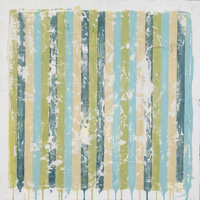NICOLE CHARBONNET
This New Orleans artist explores iconography and memory with evocative paintings that reveal the blurred line between present and past
By Elizabeth Dewberry, SOUTHERN ACCENTS

"Erased Riley #5", 2006
Nicole Charbonnet grew up playing hide-and-seek in the majestic, crumbling aboveground Lafayette cemetery in New Orleans. Today, she still lives in New Orleans, creating layered images on paper and canvas in which the present hides within the past like a child crouching between tombstones. She credits her native city for giving her a heightened sense of the lingering effects of history. “If you walk through New Orleans, you see everywhere the effects of the process of lime on surfaces,” she says, adding, “That’s true of every place, every person. It’s just more pronounced here.”
Exploring the ways we remember, both individually and collectively, and the ways we forget, she starts each work by painting a memory,an image that has long existed elsewhere in the culture in other paintings, on film, and in nature, for example, When she sands the paint down, forcing the memory to fade, and begins hiding it under other images or words, using plaster, modeling paste, and “anything else that’s lying around,” she says, to create a modernpalimpsest with a sculptural quality.
“Nothing is ever completely gone,”she says. “so even if you don’t hold a conscious memory of something, it forms the fabric and texture of who you are. I try to re-create the process your mind goes through in becoming what it is. You see something, and it reminds you of something else, another context, another feeling, even while the original image remains.”
She sometimes borrows from the paintings of artists whose work has influenced her own. “Robert Rauschenberg’s Erased de Kooning. in which he took a drawing by deKooning and erased it and called the almost-blank paper his own work of art, is a version of what I”m doing, laying down the paint, then sanding it off,” she says, “but then I start building over it.”
She also works with images from old films, especially John Ford Westerns and American film noir, playing the movies on her VCR, pausing them to photograph compelling shots, and reshaping the images both when the camera crops the film and when she crops the photos before painting the pictures onto canvas. She sees her process of “erasing” the paint and adding other layers over it as one that both celebrates and criticizes the values portrayed in the films. “As Americans, we respond to the iconography of the Wild West because it represents some of our ideals—open space, independence, self–determination,” she says. “I’m raising questions about their current viability in a changed world. I make them look old and tired, though still beautiful, to ask if it’s time to relegate them to memory.”
The images she finds herself painting these days mostly birds and trees—are influenced by her experience of returning to New Orleans after Hurricane Katrina. “I went to Audubon Park, which was just a graveyard for trees, and the birds were on the ground, shivering.” she remembers. “What happened to the trees in New Orleans is a metaphor for what happened to all of us—some of us lost parts of ourselves, some were uprooted, some died right where they were, and the rest of us who are left have no choice but to find a way to survive.”
So Nicole continues her artistic game of hide-and-seek,creating works in which the past always hides in the present, and the present seeks definition from the past.
Arthur Roger, whose eponymous gallery sells her works on paper beginning at around $3,500 and her paintings for up to $16,000, sees her work as an eloquent evocation of her visual sense of her hometown, “We’re used to seeing the past on surfaces and, textures in New Orleans, a hundred years of paint peeling off the buildings, revealing the past in layers. She explores how that process works in memory. It’s very fresh, very exciting.” And very difficult to forget.
